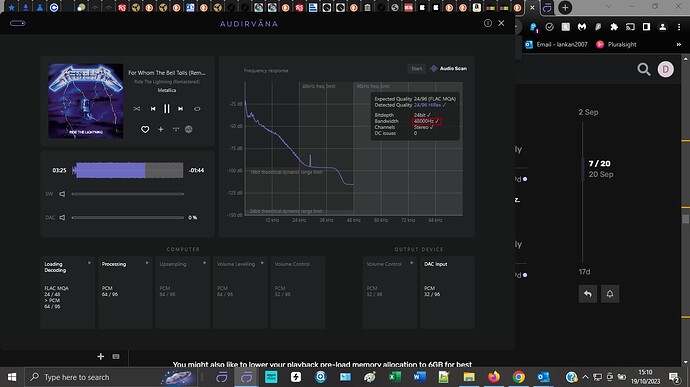Per the title, and shown in the screenshot below, there is no discrepancy in what is output to, and received by, the DAC, so this may only be an issue at the presentation layer, or am I missing something?
Isn’t it a MQA file? Maybe 48kHz is referred to the input resolution while 96kHz is referred to the resolution after the first unfolding
Indeed, it appears to be a 24/48 MQA stream, but does that mean Audirvana unfolds it and transmits the stream as 24/96? If so, why is that? I mean why not transmit as 24/48?
Must admit, as I am not a fan of MQA, I have not researched into the unfolding process that takes place en route.
How Audirvana handles MQA is in your DAC settings. It can handle the unfolding or not depending upon your choices. Make your settings selection based on the DAC capabilities and how you think it sounds best.
The DAC is not capable of MQA, so MQA unfolding is not available throughout the chain, once the stream leaves my laptop. Further, MQA is not something I miss since I am only using TIDAL for the trial period as Amazon Music HD (my main platform) is not supported by Audirvana as yet - I understand that the delay is on Amazon’s part.
Given the above, is the behaviour shown in the screenshot as expected (i.e. a 24/48 MQA stream unfolds to 24/96)?
Don’t know mqa but bandwidth is always half of resolution. If you check a regular CD it will be 22050
Audirvana integrates the MQA Core Decoder that performs the first unfolding (up to 88.2 or 96kHz) to benefit from the high resolution of the MQA audio files even without an MQA audio device. By MQA decision, the second unfolding (to 176.4 or 192kHz) can be performed only in a MQA renderer/decoder DAC.
Non MQA capable audio devices can benefit from the high resolution (doubled sample rate compared to the encoded file one) thanks to the MQA decoder integrated in Audirvana.
In this case, Audirvana brings, in addition to the general Sound Quality improvement, the decoding of the MQA file that would be played only at little above CD quality otherwise, losing all its high resolution benefits. Note that decoding the signal beyond twice the sampling rate of the encoded file (for the few rare recordings actually made above 96kHz) can only be done in a DAC MQA.
You then need to leave “Not MQA decoder” for your DAC in the Audio Settings, so that Audirvana performs the MQA decoding.
If you have a DAC that is “MQA decoder” then, you can select MQA decoder. That means that no audio processing done in Audirvana, as the DAC is doing all of the MQA decoding.
If you have a DAC that is “MQA renderer” then, you can select MQA renderer. That means MQA first unfolding done in Audirvana, and no other audio processing as the DAC is doing the other unfolding
The Blue color means that the file is “Studio authenticated”.
The Green color is for other MQA audio file.
Credit: @Antoine
@OffRoad & @Antoine, thank you for the detailed explanation.
I have since looked into this to gain a good understanding of MQA technology and now have a reasonable grasp of the unfolding process, a good explanation of which can be found here, which I certainly found quite useful:
Beyond High-Resolution
I see that it is all about minimising the bandwidth required whilst maintaining or improving a stream’s resolution. How that translates to actual fidelity is something I would be very keen to explore next.
How does it sound?
The bandwidth of a 96kHz file should be 48kHz. Like a 44.1 has a bandwidth of 22.05.
One is sample rate and the other is bandwidth.
@Jacob, indeed, it became clear when I read through the aforementioned article, even though it wasn’t solely related to MQA. Thanks.
One other question, if Audirvana unfolds/upsamples an MQA stream to a max. rate of 96kHz and the Studio recorded the original material at a sample rate of 96kHz, does Aurdivana report this (i.e. is there an indication to say whether a track is ‘Studio Authenticated’ ala Blue/Green lights that are found on DACs), or is it left to the final MQA decoder/renderer to feed this info back to the user (via the said lights)? Thanks.
Edit:
Is your answer here? Only a hardware decoder or encoder can indicate what color it is. And is should feedback this to Audirvana.
I don’t think it’s worth putting a lot of time into MQA. There is a good chance that we will hear less and less about it and it will end up the same as HDCD and DVD audio.
In addition, it is largely a marketing campaign around some encoding/decoding upsampling technology.
Many files on Tidal are ‘batch processed’ and have not been authenticated by artists or studios. Some mastering engineers or artists feel that the files are further away from the original intention than the non-MQA version.
Thanks for your reply - looks like I missed the edit.
No plans to jump on the MQA bandwagon - I had been following how the company went bust, but then it was bought out.
I was with TIDAL, but only as an experiment, and switched to Amazon Music soon after, so never really bought into the MQA hype. At the same time I never really looked into or researched MQA, so took this as an opportunity to do so, if only for educational purposes, especially since Audirvana supports MQA.
This topic was automatically closed 90 days after the last reply. New replies are no longer allowed.
